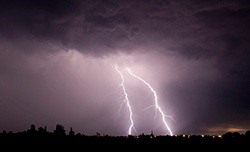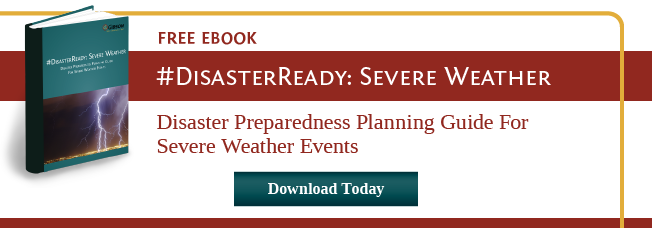 The change of seasons brings increased chance of severe weather. The temperatures can rapidly change from cold to hot, and sunny to storms. This unpredictability increases the risk of injury, death, and damage from severe weather. In order for your organization to be ready, you need to think ahead and get prepared for thunderstorms and flooding.
The change of seasons brings increased chance of severe weather. The temperatures can rapidly change from cold to hot, and sunny to storms. This unpredictability increases the risk of injury, death, and damage from severe weather. In order for your organization to be ready, you need to think ahead and get prepared for thunderstorms and flooding.
Thunderstorms
A staple of spring weather is the thunderstorm. And every thunderstorm is dangerous! Aside from the heavy rain and lightning, they can bring strong winds, hail, flash flooding, and even tornadoes.
All thunderstorms produce lightening. Though you may think lightening deaths are rare, Ready.gov still reports lightening as one of the top three storm-related killers in this country. The number of fatalities have decreased in the past 30 years, but lightening is still a very dangerous product of thunderstorms.
What can you do?
- Monitor for severe thunderstorms in your area. Use a National Oceanic and Atmospheric Administration (NOAA) Weather Radio or the NOAA’s National Weather Service website.
- Understand your community’s warning system and the terminology for server thunderstorms, a watch, and a warning.
- Prepare your employees. Establish a shelter location. Discuss the emergency plan with all employees. Review it with them on a regular basis.
- Identify possible hazards in your office and on your property. Are there are any rotting trees or branches that could fall? Are the gutters clear? Is the roof showing signs of leaking?
- Look over your business continuity plan and consider the “what if” scenarios. If the storm knocks out your power, how will you communicate and continue to serve clients? If the storm damages your building, how will you continue to operate?
Flooding
Some regions are more prone to flooding than others, but it can occur anywhere. In fact, flooding is the most common natural disaster in the country.
What are flood-related hazards? The most common are: flash flooding, river flooding, storm surge and coastal inundation, burn scars/debris flows, ice/debris jams, snowmelt, dry wash, and dam breaks/levee failure. For more information on each type of hazard, visit the NOAA website.
The first step to getting your business ready for potential flooding is to know your risks. You need to understand the risks to your organization, specific to the areas where you are located. Are you located in a floodplain? On the roads you most often travel, where would water be most likely to collect? What is the quickest way to get to higher ground?
In general, the Midwest is more at risk during the heavy rains of spring and summer. But there are resources available to look into more specifics. The NOAA has tracked all flood events from 1996-2013 and depicted them in a map, as well as an interactive resource to learn more about the types of flooding experienced in each state.
There are numerous resources available to get your organization prepared for a flood. Here are a few to check out:
- FEMA offers a Flood Playbook to help prepare your organization.
- FEMA and American’s PrepareAthon have resources for a variety of hazards, including floods.
- Agility Recovery provides a Flood Preparedness Checklist to guide you in your preparations.
- NOAA has a website dedicated to flood safety where you can find helpful information for individuals, families, and businesses.
Getting Ready For Spring
Aside from getting more familiar with the hazards associated with thunderstorms and floods, the following are steps to take as you get your business ready to handle whatever extreme weather spring may throw at you:
Review your disaster plan – is your emergency alert system ready to go? Do all employees understand the emergency plan? Have you tested your plan recently?
Review your insurance policy – Talk with your advisor to ensure your policies are properly updated to reflect any changes your organization has made recently and to be sure you are ready for the risks severe spring weather brings.
Have your offices and equipment inspected – Did your roof or gutters experience any damage over winter? Is your HVAC system operating properly? If you have a backup generator, is it in good working order?
Conduct spring cleaning – Take a look at your emergency kits – are they well-stocked, do any old items need to be replaced? What about around your property – has the melting snow left you any messes to clean up?
Don’t wait until spring storms start. Take action to ensure your organization is prepared for the dangers severe spring weather brings.





